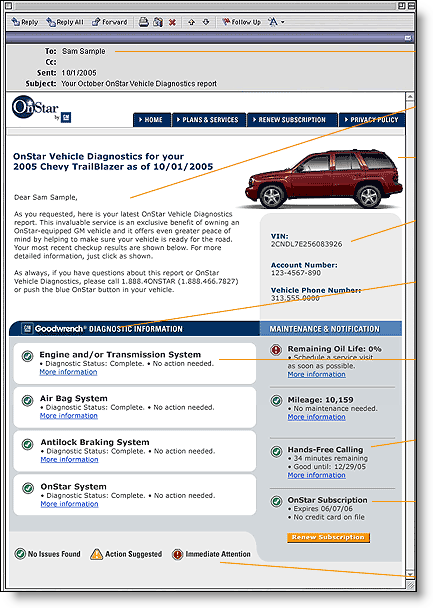The first widespread use of online features for overall corporate branding was the now-famous fall of 2002 Bank of America television advertising campaign touting it’s recently-set-free bill payment program. At the time the bank said that these advertisements were some of its most effective TV spots of all-time with recall percentages through the roof.
Three years later you see online features used in all sorts of media campaigns. Two print advertisements caught our eye this month.
-
Chase Bank ran a three-quarter page color ad in The New York Times on Oct. 9 focusing on its free email alerts using the following headline:
The morning news.
The morning weather.
Maybe even your morning balance.The ad was mostly white space with a smaller picture of a 30-something guy lounging in his Adirondack chair on his deck in the woods with laptop and coffee (evidently enjoying a wireless connection).
Our take: Good, but too subtle; unlikely to increase awareness of alerts to any great extent.
– -
Much more interesting, though unrelated to banking, was the full-pager from General Motors introducing its OnStar service running in the A-section of the Oct. 13 Wall Street Journal. The title read:
Introducing
OnStar Vehicle Diagnostics.
A monthly email from your vehicle. The picture featured a woman peering at her laptop on the patio with her car in the background. On the laptop screen was a message, blown up in the lower part of the ad (click on inset for similar message), summarizing the mechanical condition of her 2006 Chevrolet Impala.
The picture featured a woman peering at her laptop on the patio with her car in the background. On the laptop screen was a message, blown up in the lower part of the ad (click on inset for similar message), summarizing the mechanical condition of her 2006 Chevrolet Impala.
Our take: Extremely well done, demonstrating an almost unbelievably valuable service that most wouldn't otherwise have known about; should increase awareness dramatically.
Analysis
You can only talk about great service and free checking so many times. Online features that help improve perceived security and/or financial control are becoming interesting to a wider cross-section of customers.
For example, Wells Fargo took an essentially plain feature, a combined online statement, and turned it into My Spending Report (see previous NetBanker article, Feb. 17, 2005), a point of differentiation for its online services, and by extension, the bank as a whole.
–
We don’t work at an ad agency, so we won’t begin to try to tell you how to cost justify large print ad in the local paper. But most financial institutions devote at least some of their advertising budget to so-called “image” spots and if you serve a tech-savvy market such as NYC, 2006 would be a good time to test online-oriented spots to see if they bump up your brand and ad recall numbers.
—JB



